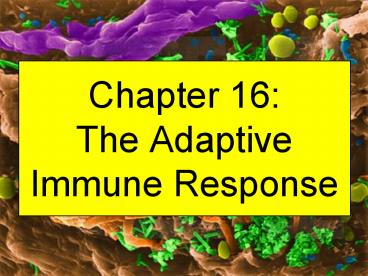Chapter 16: The Adaptive Immune Response - PowerPoint PPT Presentation
1 / 29
Title:
Chapter 16: The Adaptive Immune Response
Description:
T cells, during their development in the thymus, are subject to two round of selection. ... The second round is Negative Selection where T cells that recognize self ... – PowerPoint PPT presentation
Number of Views:122
Avg rating:3.0/5.0
Title: Chapter 16: The Adaptive Immune Response
1
Chapter 16The AdaptiveImmune Response
2
Important Point
If you are having trouble understanding lecture
material Try reading your text before
attending lectures. And take the time to read it
well!
3
Adaptive Immunity
- In contrast to the innate immune response, which
is always ready to respond to patterns that
signify damage or invasion, the adaptive immune
response matures throughout life, developing from
the immune system arsenal the effective response
against specific invaders as each is
encountered. - An important hallmark of the adaptive immune
response is that it has memory, a greatly
enhanced response to re-exposure. - Key to understanding adaptive immunity is the
interactions between antigens and immune-system
molecules, such as antibodies. - Also important is the concept of tolerance, which
is the ability of the immune system to ignore
common body molecules.
4
Adaptive Immunity
5
Primary Lymphoid Organs
The primary lymphoid organs, are bone marrow and
the thymus, where lymphocytes originate and/or
mature (depending on type).
6
Secondary Lymphoid Organs
The secondary lymphoid organs, such as Lymph
Nodes, are the sites of interaction among immune
system cells including with antigens presented by
Antigen Presenting Cells.
7
Antigens
- Antigen stands for Antibody Generator.
- Antigens are molecules that are potentially
recognized by adaptive immune-system molecules. - Recognition specifically means a binding
between the antigen and the immune-system
molecule, such as between a immunogen and an
antibody. - Note, however, that an antigen within its self
environment will not normally elicit (i.e.,
cause) an immune response. - To describe antigens found in non-self
environments, the term Immunogen is more correct,
though we wont bother making this distinction. - An antigen consists of a number of recognizable
regions known as Antigenic Determinants, a.k.a.,
Epitopes.
8
Antibodies, Antigens, Epitopes
9
Epitopes, T-Depend. Antigen
Epitope
Epitope
Epitope
Etc.
Epitope
Epitope
Epitope
10
Antigen-Antibody Interaction
This is an individual antigen found on the
surface of a virus. There are a number of
chemically and physically distinct regions on it
to which different antibody types (blue) might
bind.
11
Antigen-Antibody Interaction
Different antibodies produced by different B
cells are able to attach to distinct epitopes
found on the same or different antigens.
12
Antibody, a.k.a., Immunoglobulin
Red Flag host-to-antibody binding region.
Note the two identical antigen-binding sites
both are contained within identical variable
regions.
Red Flag host-to-antibody binding region.
13
Immunoglobulin in 3D
Antigen-binding region.
Antigen-binding region.
And remember, an Antibody is not an
Antibiotic!!!!!
Red Flag host to antibody binding region.
14
Immunoglobulin Classes
Longest lived Ab present in colostrum.
Most abundant class (except in serum).
Associated with allergies.
15
Immunoglobulin Actions
Recall that C3b can bind directly to cell.
Prevents binding to host tissues.
Pilus as well as flagellum binding.
This is a host cell, covered with foreign
antigens and therefore with antibody.
These are now available for phago-cytosis.
16
Clonal Selection Theory
Applies to both B and T cells.
Takes place in 2 lyphoid organs.
T cells are associated with cell-mediated
immunity.
B cells are associated with Ab (Ig) production.
17
Antigen Presentation by B Cell
Note binding by only one-half of the Y.
Results in production of Abs against T-Dependent
Antigens (no T-helper binding, then no Ab).
18
If T Binding then Expansion
Memory B cells long-lasting immunity.
T-helper binding occurs here.
19
T-Independent Antigens
Including carbohydrate portion of LPS.
20
Epitopes, T-Independ. Antigen
Epitope
Epitope
21
Pri. Sec. Immune Response
Clonal Expansion of Memory B cellsthere are lots
of em!
Clonal Expansion of B cells.
22
1 2 Immune Response (more detail)
23
Pos Neg T Cell Selection
- Both T cells and B cells are derived from
hematopoietic stem cells found in bone marrow. - T cells migrate to the thymus for further
development (and hence the T in T cells, though
the B in B cells stands for Bursa). - T cells, during their development in the thymus,
are subject to two round of selection. - The first round is Positive Selection where only
T cells that can bind MHC are retained. - The second round is Negative Selection where T
cells that recognize self antigens in association
with MHC are deleted. - The resulting T cells, both helper and cytotoxic,
consequently can bind MHC (II or I,
respectively), but only if complexed with
non-self antigens.
24
Antigen Recognition by T Cells
Recognition by Cytotoxic T cell (CD8 receptor)
Recognition by Helper T cell (CD4 receptor)
25
CTL Immune Surveillance
26
Cytotoxic Consequences
I.e., they tell their friends (other cytotoxic
T cells).
Apoptosis is cellular suicide which here is
induced by the CTL.
27
Stimulating T-Helper Cells
Macrophages and Dendritic cells present antigens
to, and thereby stimulate, T-helper cells.
28
Adaptive Immunity
Good summary of Adaptive Immunity!
29
Link to Next Presentation































